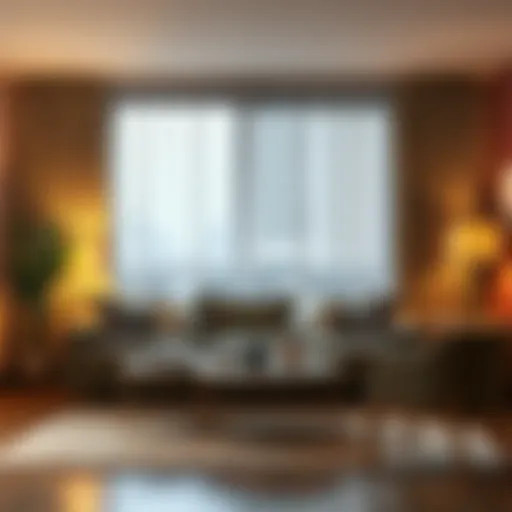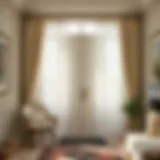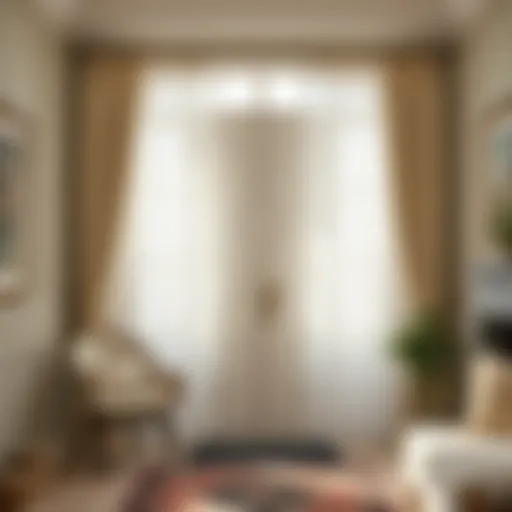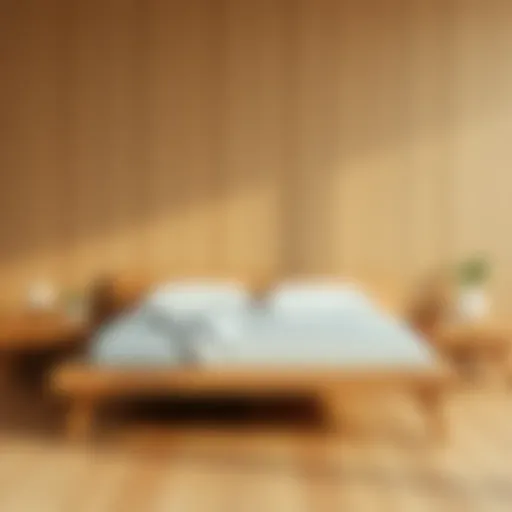Dining Table Legs for Glass Tops: A Complete Guide
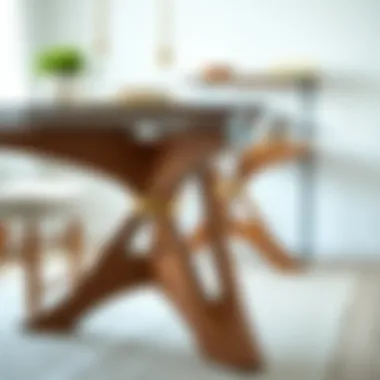
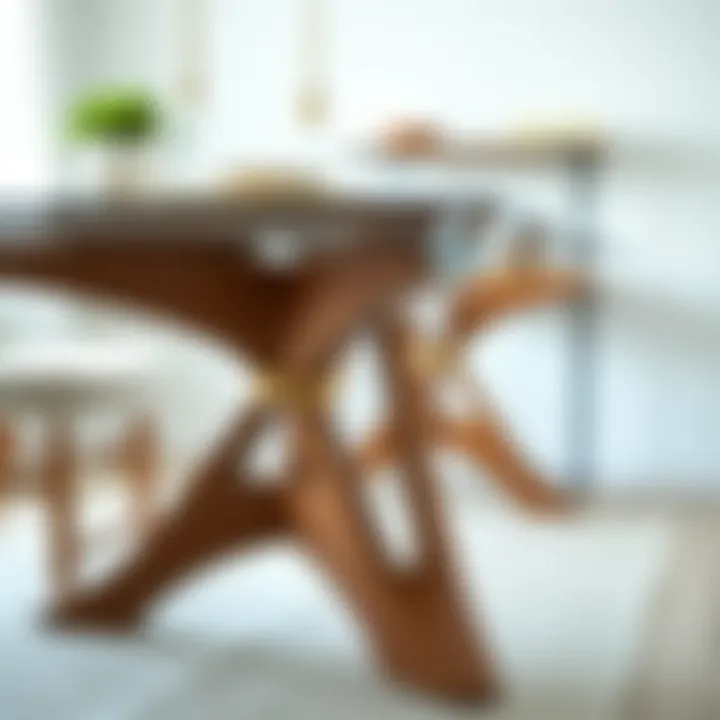
Intro
Choosing the right dining table legs for a glass top is not merely about aesthetics; it is also a matter of practicality and functionality. Glass table tops can lend a modern and sophisticated look to dining spaces, but they require a careful selection of legs to ensure stability and visual harmony. Homeowners, renters, designers, and DIY enthusiasts alike should consider various factors when opting for the table legs that will support these elegant surfaces.
In this guide, we will explore the crucial balance between form and function. The interplay of materials, styles, and design considerations can significantly impact not only the durability of the table but also how it fits into one's personal style or overall decor theme. From the raw appeal of wood and metal to the sleekness of modern designs, we'll take a close look at how to elevate your dining area with the right combination of glass and support.
Understanding the Role of Dining Table Legs
Dining table legs serve as much more than mere supports; they're central to the overall feel of the dining space. In this section, we will explore how these crucial components ensure both stability and aesthetics in relation to glass tops, an increasingly popular choice in modern interiors.
Structural Integrity and Support
Understanding Load Distribution
Load distribution is a fundamental concept when it comes to stability and durability. It refers to how weight is spread across the table legs, ensuring no singular point bears too much pressure. Think of it like balancing a seesaw: if one side is heavier, it tips over. A well-designed table leg, when paired with a glass top, avoids this precarious situation and maintains equilibrium.
A primary characteristic of effective load distribution is its evenness. When dining with family or friends, the weight of people leaning over the table, or the load of dishes piled high, is evenly shared amongst the legs. This is particularly beneficial for glass tables, as they are more fragile than wood or metal surfaces. Furthermore, a unique feature of glass tops is their transparency, which minimizes the appearance of thickness. Thus, a well-distributed load via sturdy, properly placed legs avoids unsightly bending or warping.
Material Strength Considerations
Material strength is another critical factor that practically resonates with durability. When choosing legs for a glass top, considerations of material can mean the difference between a reliable piece and a potential hazard. Hardwoods, for instance, offer impressive load-bearing capabilities along with aesthetic appeal. This is valuable in ensuring that the table not only withstands the weight but adds to the charm of the room.
One of the standout aspects of material strength is its longevity. High-quality materials resist the natural wear and tear over time, preserving the elegance of your dining area. However, not every material will provide the same stability; thus, understanding the contrasts among different wood types or metals becomes essential. Heavy metals might provide strength but can become cumbersome, while lighter woods may be inadequate under excessive weight. Striking that delicate balance is vital for both safety and style.
Aesthetic Impact
The Visual Element of Table Legs
The visual element of table legs plays a pivotal role in enhancing the dining experience. It’s often the legs that make or break the table’s aesthetic appeal. Sleek and modern legs can give off an air of sophistication, while ornate ones might evoke a sense of nostalgia. This array of design options serves as a canvas for one’s creativity, and when coupled with a glass top, the legs can either blend seamlessly or deliberately contrast.
One interesting characteristic of this visual element is its transformative power. The right choice of legs can make an otherwise ordinary glass table look strikingly extraordinary. Conversely, poorly chosen legs might cheapen the appearance. A potential drawback is that the leg design must still comply with functional stability, which can sometimes limit creative expression.
Integrating Styles with Glass Tops
When it comes to integrating styles with glass tops, it’s a dance between beauty and functionality. Styles can range from rustic to ultra-modern, and finding the perfect match with the elegance of glass adds an intriguing dimension to the dining space. This feature becomes incredibly important in open-plan homes where seamlessly blending various styles is often crucial.
A notable aspect of this integration is its flexibility. Glass allows for a light and airy feeling, which means that table legs do not need to overpower the design. The clear surface reflects light and colors, and thus incorporating the right kind of legs can highlight the entire room's decor. Yet, achieving this balance might require careful selection to ensure legs complement rather than overwhelm the space.
"The beauty of a dining table isn’t just in its surface; it’s rooted deeply in its legs - the unsung heroes of dining spaces."
In sum, understanding the crucial role of dining table legs is vital for anyone looking to harmonize aesthetics and functionality - especially when dealing with the delicate nature of glass. The right legs not only provide stability but also enhance the overall design, enabling you to create a dining area that is both inviting and stylish.
Types of Materials for Dining Table Legs
When it comes to dining table legs, the choice of material plays a crucial role in both the functionality and aesthetic of the piece. Different materials have distinct characteristics, contributing various benefits and considerations. Selecting the right material can dictate durability, how well the design fits into your decor, and even ease of maintenance. Materials also impact the overall feel and longevity of the table. Understanding the ins and outs of wood, metal, and combination materials gives you the upper hand in creating the perfect dining area.
Wooden Legs
Wood has been a time-tested choice for table legs, offering warmth and character. The natural grain patterns and textures give an organic touch to your dining space, making it feel welcoming and intimate.
Characteristics of Different Wood Types
Different types of wood bring unique qualities to the table—literally. For instance, oak is known for its strength and durability, while pine offers a lighter, more casual feel. Walnut, on the other hand, exudes elegance with its rich colors.
- Oak: Resilient and sturdy, great for high-traffic areas.
- Pine: Affordable, lightweight, and easy to work with but can dent easily.
- Walnut: High-end appeal with durable finish, often used in modern designs.
The grain and texture vary across wood types. Walnut's smooth finish versus the roughhewn quality of reclaimed wood can set the mood you desire in your dining area. However, wood may require periodic maintenance, such as refinishing or sealing, to protect against damage.
Finishing Techniques for Wood
Finishing can transform a basic wooden leg into a stunning focal point. Whether it’s a simple stain to accentuate natural grains or a glossy lacquer for a polished look, finish can influence both functionality and aesthetics.
- Staining: Enhances grain visibility while allowing for color customization.
- Lacquering: Offers a protective layer that's also visually striking.
- Oil Finishing: Provides moisture resistance and highlights natural beauty, but may not last as long as other finishes.
With a good finish, wooden legs can withstand spills and stains, adding longevity. But be mindful; the choice of finish also alters the leg's texture and sheen, which could clash with the rest of your decor.
Metal Legs
If you're leaning towards a modern aesthetic, metal legs can deliver a sleek and sturdy option. They provide a different touch that conveys sophistication while also being functional.
Advantages of Metal in Modern Design
Metal construction yields remarkable strength compared to wood, allowing for slimmer profiles without sacrificing stability.
- Strength: Can support heavier glass tops due to their durability.
- Versatility: Available in various finishes, such as matte, shiny, or even brushed, easily aligning with different styles.
- Lightweight Options: Despite the strength, some metals such as aluminum are surprisingly light.
These characteristics make metal legs a go-to for urban or contemporary settings. However, it's essential to consider that cold metallic surfaces might not always suit traditional or rustic interiors.
Corrosion Resistance and Durability
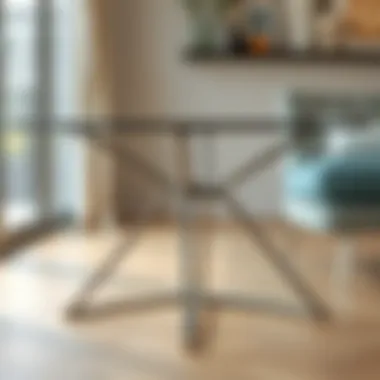
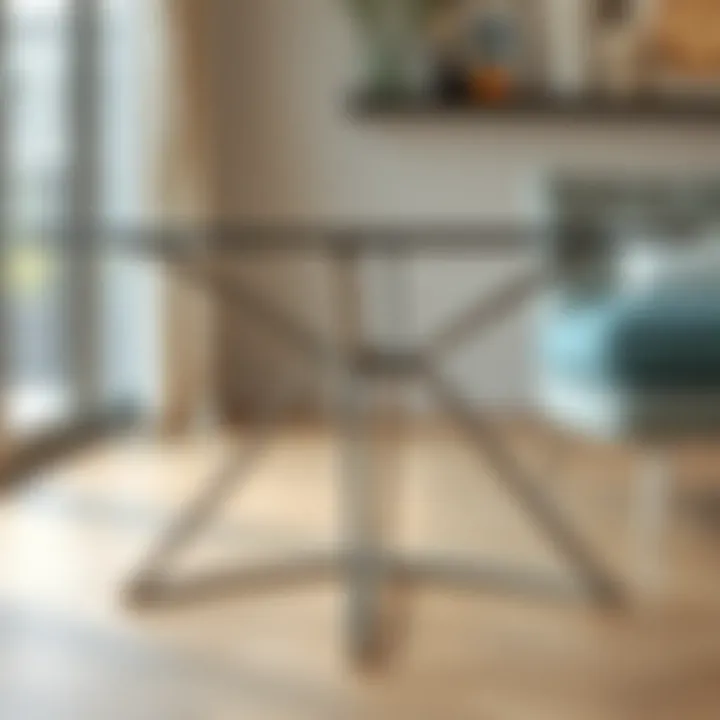
Corrosion resistance is a key feature for metal materials, particularly depending on the finish applied. Stainless steel, for example, boasts resistance to rust, making it an ideal choice for areas with high humidity or moisture.
- Stainless Steel: Resists tarnishing and oxidation, perfect for longevity.
- Powder-coated Finishes: Adds an extra layer of protection against scratches and fading.
While metal offers incredible durability, it may still be prone to scratches if not treated properly. Therefore, regular maintenance to avoid any chipping or scratches is advisable.
Combination Materials
Combining materials can bring a unique twist to your dining table design. By marrying wood and metal, you can capture the best of both worlds.
Exploring Hybrid Designs
Hybrid designs introduce a fusion of aesthetics. For instance, a wooden top with metal legs not only emphasizes contrast but also maintains structural integrity. - Contrast: A striking visual appeal that can elevate one's decor.
- Customization: Flexibility in design means you can get more abstract with forms and colors.
These combinations often speak to modern sensibilities while allowing for creativity, giving you the freedom to choose designs that reflect personal taste.
Balancing Aesthetics and Functionality
The goal of hybrid designs should always be to achieve a balance between how the product looks and how well it functions. For example, adding wood accents to metal legs can soften a stark look, making the overall design more inviting. - Visual Weight: Combining lighter materials with heavier ones can create balance.
- Functional Design: Assessing how each material interacts in terms of stability and wear.
Combining materials may require cautious planning, as ensuring the behavior of the materials under various conditions is paramount to your table’s longevity.
Choosing materials wisely can lead to fabulous dining experiences that last, both in terms of function and style. Remember to prioritize what matters most in your space.
Understanding various materials and their respective strengths lets you craft a dining area that is both well-founded and visually captivating.
Style Considerations for Dining Table Legs
When it comes to dining tables, legs may not be the first thing that pops into one's mind, yet they play a pivotal role in both aesthetics and functionality. Selecting the right style for dining table legs can transform an ordinary glass top into a centerpiece that captures attention and complements the overall decor of the space. We’ll explore various styles that not only introduce visual intrigue but also ensure stability and support for the glass tops.
Contemporary Designs
Sleek Profiles and Minimalism
Sleek profiles embody the essence of modern design. They often feature clean lines, a streamlined appearance, and a minimalist approach that draws the eye without overwhelming the space. This characteristic of contemporary legs allows for versatility across various decor styles. In a home setting, a table with sleek legs paired with a glass top can create a spacious feel, especially in smaller dining areas.
The popularity of this design is linked to its ability to adapt; they are beneficial for those who seek to maintain an open, airy environment without compromising on style. However, it's important to also consider the potential downside; this stark minimalism could come across as too cold or sterile, depending on the surrounding furniture.
Color Schemes and Finishes
Color schemes and finishes breathe life into dining table legs. They transform basic elements into striking focal points, adding depth and warmth to the overall aesthetic. Popular choices include matte black, brushed gold, and natural wood grains, which can meld seamlessly with various interior setups.
These finishes allow for personal expression. The unique feature here is how the finish can both enhance a minimalist design and add character to more ornate styles. On the flip side, darker colors can show dust and scratches, potentially requiring more maintenance, but for many, this trade-off is worth the visually inviting environment it creates.
Traditional and Vintage Styles
Timeless Elegance in Design
Timeless elegance defines traditional and vintage styles. Not just about aesthetics, these designs often embody stories and tradition, making them a popular choice for homes laden with history and character. The intricate carvings or robust materials such as solid woods reinforce the idea of durability and craftsmanship, resonating well with the values of quality.
This elegance appeals to those wanting to evoke a sense of nostalgia while ensuring their table serves a practical purpose. Nevertheless, these ornate designs may clash with more modern interiors, so careful consideration is needed when pairing them with glass tops.
Complementing Antique Glass Tops
Complementing antique glass tops requires a discerning eye. This style focuses on harmonizing the details of table legs with the intricacies of the glass itself. Antique glass often has unique features like bubbles or waves that can enhance the table's charm when paired with the right legs.
One key characteristic of this pairing is the ability to evoke a sense of timelessness. A well-chosen leg design can reflect the craftsmanship of the glass, creating a cohesive piece. Yet, be aware that this approach might limit options for future redesign; not every style of leg will mesh well with antique glass, which necessitates a bit more careful planning.
Industrial Aesthetics
Raw Materials and Exposed Structures
Raw materials and exposed structures lean heavily on the industrial aesthetic, favoring a rugged and unfinished look. Metal legs designed with visible welds or rough finishes cater to those who appreciate authenticity in design. This characteristic sparks intrigue and embodies modern sophistication while making a bold statement.
Choosing industrial legs can be beneficial as they often provide high durability and strength. However, this aesthetic might not suit every space; it could feel out of place in more traditional or soft environments, requiring mindful integration.
Creating Contrast with Glass
Creating contrast with glass elevate the visual dynamics of a table. The tension between hard metal and delicate glass not only provides a striking appearance but also emphasizes the unique properties of both materials. The juxtaposition can capture attention and can inspire conversations around the dinner table.
This approach is particularly suited for those with a modern or eclectic taste. Yet, the downside may be seen with excessive industrial finishes overshadowing the glass's elegance, diminishing its effect as a centerpiece. Balancing these elements is key for achieving an inviting atmosphere.
The style of dining table legs can set the tone for the entire dining experience, combining visual appeal with functional integrity. It is essential to choose wisely, considering not just the appearance but also the impact on the overall space.
Dimensions and Proportions
In the realm of selecting dining table legs for glass tops, understanding dimensions and proportions is pivotal. It’s not just about aesthetics; wrong sizing can make a table feel off-balance or even unsafe. Both height and width play critical roles in the functionality and style of a dining table.
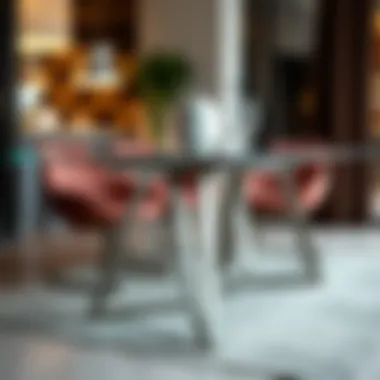
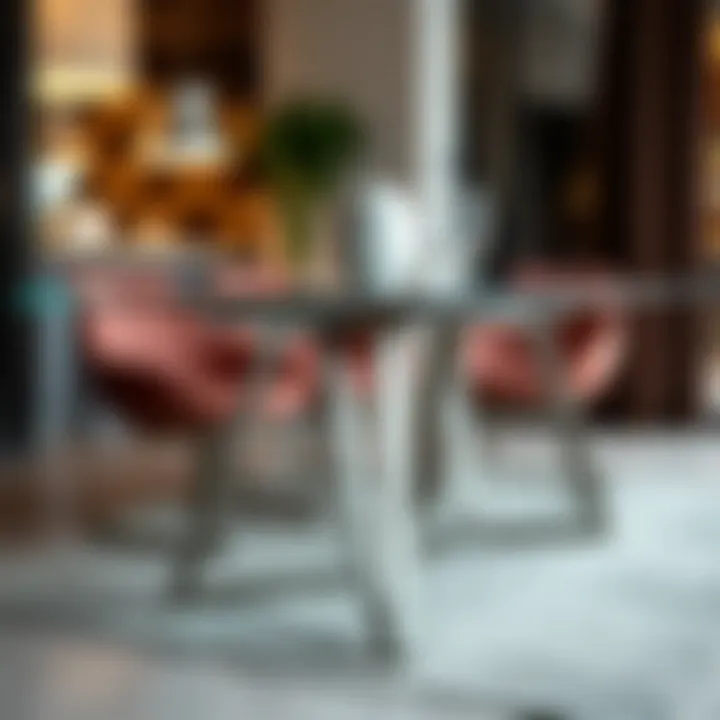
The key lies in achieving harmony between the table leg design and the glass top. This section emphasizes how optimal dimensions enhance the stability of the table while contributing to an overall pleasing visual experience.
Height Considerations
Standard Dining Table Heights
Standard dining table heights usually range from 28 to 30 inches. This height is universally accepted as comfortable for most people when seated, allowing for an enjoyable dining experience. The simplicity of this height specification is a major reason it’s so widely embraced.
Choosing standard heights means you avoid the guesswork involved in custom projects. A table that meets these measurements will allow your glasses and dishes to sit nicely above your knees without any awkward stretching. A unique advantage of standard heights is that they streamlines the buying process; there's a broad selection of pre-made legs available, giving homeowners more freedom in decor choice.
However, the downside can sometimes be the lack of personalization. If you crave uniqueness, sticking to the standard may not fit your vision.
Adjustable Leg Options
Adjustable leg options open up a world of flexibility. These legs are particularly appealing for multifaceted living spaces. Homeowners can modify the height to better fit their needs—be it for casual dining or elevated settings. The characteristic of these legs is their adaptability, making them a popular choice for families with children or those who host a variety of gatherings.
The unique feature of adjustable legs allows users to cater to different seating arrangements without the need for entirely different tables. This not only saves money but also space, as one table can serve multiple purposes. However, it’s essential to keep in mind that mechanism breakdown can occur over time, potentially leading to stability issues if not regularly checked.
Width and Stability
Ensuring Balance with Glass Tops
The width of dining table legs is crucial for ensuring balance, particularly with glass tops. Wider legs generally provide a more stable base, reducing the likelihood of wobbling and ensuring that the glass is safely supported. This makes wide legs a choice that often offers peace of mind for homeowners concerned about the fragility of glass.
What sets this aspect apart is that wider legs can enhance the visual appeal of the table, drawing the eye positively and promoting a solid aesthetic. They can often accompany bolder designs and materials, melding function with style. On the flip side, excessively wide legs might consume space, making the table feel bulky in smaller areas.
Designing for Space Constraints
Designing for space constraints is a must for many homeowners. Most dining areas have specific dimensions that can limit leg choice. This section acknowledges those practicality necessities while also pushing boundaries of creativity.
A characteristically sleek design can seamlessly fit into tighter spaces without sacrificing stability. This approach often leads to innovative solutions. For example, slim, tapered legs retain elegance while adhering to space limitations. Additionally, these types of legs can create an illusion of a larger space, which is a clever strategy for smaller dining areas.
However, be cautious of going too slim. If the legs are too narrow, they may undermine stability—typically a scenario no one wants to experience during a dinner party. Sounds manageable, right? A balanced approach to width ensures both elegance and function, keeping the best elements of design intact.
Installation Techniques
Understanding how to properly install dining table legs for glass tops is crucial. This section will guide you through effective strategies, helping you achieve a stable and visually appealing table that feels solid. The right installation can prevent wobbling and potential damage to the glass itself. Many do-it-yourself projects falter at this stage, so getting the mechanics right can mean the difference between a project that gleams with style and one that feels haphazard.
Securing the Legs to Glass
Using Special Hardware
Securing the legs to your glass top rightly is no simple task. Here, using special hardware acts as a linchpin in your table's overall sturdiness. Think of this hardware as the backbone, ensuring that the legs are held firm. One key characteristic of this hardware is its capacity to absorb tension without compromising stability. This is particularly crucial where glass is involved, as it requires careful handling to avoid breakage.
The unique features, such as mounting brackets or cushioned washers, allow the legs to flex slightly without causing stress fractures on the glass. However, opting for specialized hardware does require an upfront investment, both in cost and installation effort. In the long run, though, it's a wise choice that pays dividends in longevity.
Maintaining Stability During Assembly
To keep your project on the straight and narrow, maintaining stability during assembly is of utmost importance. This phase ensures everything remains aligned while you secure the legs. A key characteristic is incorporating leveling devices or clamps to hold everything in place. This not only aids precision while you attach the legs but minimizes the chances of misalignment before the glue or screws set. The challenge here lies in having steady hands and patience. If you rush this step, you might end up with an uneven table or, worse, a shattered glass top. By paying attention to this aspect, you’ll find your table assembly process smoother and less prone to errors.
DIY Installation Tips
Tools Required for Efficient Assembly
Starting a DIY project without the proper tools is like cooking without a recipe. For efficient assembly of dining table legs, you’ll want essential essentials like a power drill, screwdrivers, and a measuring tape. One of the prominent advantages here is that having these right tools at your disposal saves time and boosts your confidence in the process. Using the specific drill bits for glass and metal can enhance the precision cut, which is crucial in this case. The unique feature of using quality tools not only makes assembly easier but also helps prevent damaging the materials at hand, giving you both ease and peace of mind.
Common Pitfalls to Avoid
Even seasoned DIYers can hit bumps along the way. Knowing common pitfalls to avoid is your insurance against trouble. One of the most frequent missteps is neglecting to measure accurately; it’s a classic mistake that can lead to legs that are too short or insecurely fastened. Another common error is overlooking the need for a level surface during assembly. Installing on an uneven surface can result in a table that tilts, which not only looks unprofessional but can weaken the integrity of the installation as well. Adhering to these tips helps maintain the aesthetics and functionality of your dining table, making the whole project worthwhile.
"A project rushed is a project regretted; take your time to ensure every detail is right."
By exploring these installation techniques thoroughly, you’ll not only secure the legs of your table well but also enrich your overall building experience.
Maintenance and Care
Maintaining your dining table, especially one with a glass top, is crucial for both aesthetics and longevity. It’s not just about keeping it looking sharp; it’s about preserving its structure and usability. Regular upkeep prevents early wear and potential damages, which can save you a pretty penny in the long run. Also, a well-cared-for table retains its charm, offering a welcoming atmosphere for dining experiences.
Cleaning Techniques for Different Materials
Routine Maintenance for Wood
Wooden legs require special attention when it comes to cleaning and maintenance. Regular dusting, followed by the occasional deep clean, can preserve the beauty of the wood and ensure it lasts for years. A microfiber cloth works wonders; it traps dust and dirt without scratching the surface. An important aspect of routine upkeep involves choosing the right cleaning solution—mild soaps mixed with warm water can do the trick without harming the finish.
One key characteristic of maintaining wooden legs is knowing when to reapply finish or sealants. Wood's porous nature tends to absorb moisture, which can lead to warping or cracking if not properly protected. This can make routine maintenance not only beneficial but also a necessary task for keeping your table legs pristine over time.
However, care must be taken when applying wax or oils, as too much can result in an overly glossy surface that becomes a fingerprint magnet. So, using a light touch during application is essential.
Protecting Metal Against Corrosion
Metal legs bring a modern touch but they also require specific care to prevent corrosion. Understanding how to protect them from humidity and exposure is vital. A periodic wipe-down with a damp cloth can help keep grime from settling in. If your table has metal legs made from materials like steel or iron, applying a rust inhibitor can be immensely helpful. This process helps preserve the integrity of the metal and keeps it looking fresh.
The unique feature regarding metal protection is the ability to coat with oxidizing solutions, which can create a barrier against moisture. Many find this method exceptionally effective due to its long-lasting results. Yet, it’s worth noting that these coatings can sometimes alter the metal's natural appearance.
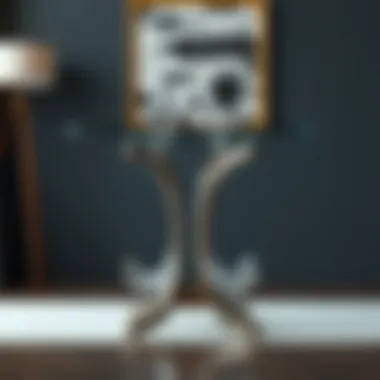
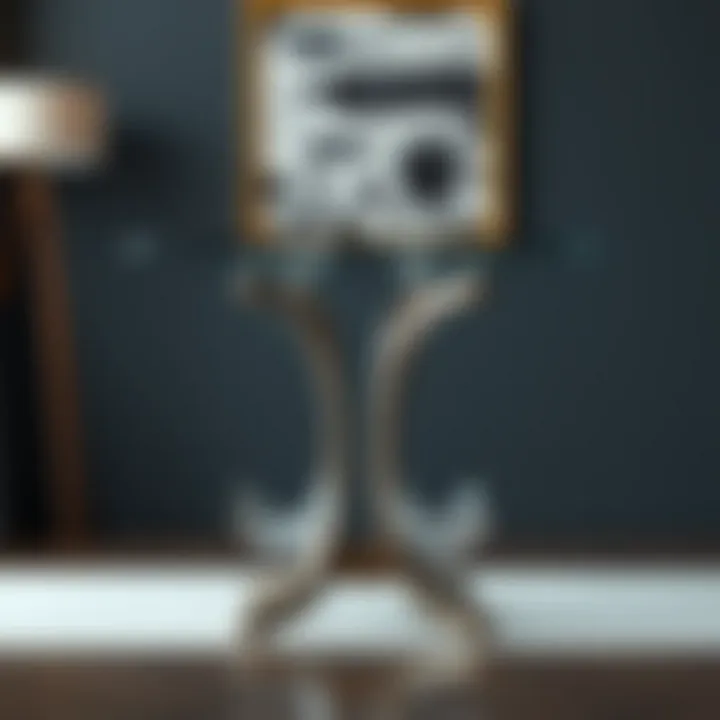
Preventing Damage to Glass Tops
Using Coasters and Protectors
Preventing scratches and other damages to glass tops is where coasters and protectors shine. Not using them can lead to unsightly marks or, even worse, cracks. Coasters provide a simple yet effective way to keep drinks from leaving rings or moisture on the glass surface. Products made of felt or silicone are particularly popular, both for their soft touch and reliable grip.
What’s great about using these protectors is that they not only prevent damage but can also add style to your table setting. The right choice can complement the table’s design while minimizing potential harm.
Yet, while coasters are a practical choice, they need to be used consistently. Leaving drinks unprotected on the table just because it's convenient can backfire—resulting in costly repairs.
Temperature Regulation and Glass Care
Temperature fluctuations can cause glass to expand and contract, which is a significant factor when maintaining glass tops. Ensuring that hot dishes are not placed directly on the glass is paramount. A good practice is to use trivets or heat-resistant pads to prevent stress fractures that may occur from sudden temperature changes.
Another vital aspect of temperature regulation is avoiding direct sunlight over long periods, as excessive heat can weaken the glass itself. Keeping curtains or shades can help manage this, protecting your dining surface from undue stress.
Overall, how you care for your glass can make a difference in its longevity. Implementing conscious habits regarding temperature exposure keeps the table looking beautiful for longer, allowing it to maintain its allure in your home.
Regular maintenance and care not only enhance the durability of your dining table but also ensure that this piece remains a centerpiece of lively gatherings and shared meals.
Customization Options
Customization plays a pivotal role when it comes to selecting dining table legs for glass tops. The choice of legs not only supports the structure but also shapes the overall aesthetic of the dining space. Customization options allow homeowners and designers alike to craft unique expressions that resonate with their personal style and functional needs. Whether it’s about selecting the right materials, finishes, or even bespoke designs, these choices significantly enhance the visual narrative of any dining area. Taking time to navigate through these options can ensure both stability and style, resulting in a well-rounded dining experience.
Bespoke Leg Designs
Collaborating with Local Artisans
When one engages with local artisans for bespoke leg designs, they tap into a well of craftsmanship and creativity that mass production often lacks. Local artisans typically possess a profound understanding of various materials and techniques, allowing them to create tailored pieces that reflect the homeowner's vision. The unique characteristic of collaborating with these skilled craftsmen is the bespoke nature of their work; no two pieces are ever the same. Each table leg can be intricately designed to complement the glass top, ensuring harmony in the dining setup.
This approach is beneficial because it encourages a personal touch and supports local economies. However, one must consider that this option often comes at a premium cost and may require a longer lead time for completion. Nevertheless, the advantages often outweigh the disadvantages, making it a popular choice for those seeking distinctive leg designs that stand out.
Personalizing for Unique Aesthetics
Personalizing table legs for unique aesthetics is another key aspect of customization. This facet allows homeowners to breathe life into their dining spaces by choosing designs, shapes, and colors that resonate with their style. A key aspect of this personalized approach is the emphasis on individual expression—crafting a piece that mirrors one’s taste and personality.
Choosing personalization can elevate the dining experience, especially when blending traditional and contemporary styles. For example, one might opt for geometric metal legs combined with an antique-style glass top, creating a striking contrast. While this enhances uniqueness, it also requires careful planning to ensure that the design aligns with the overall decor. The drawback is that personalized pieces can be time-consuming to design and create, but the end result is often a perfect reflection of the homeowner’s vision.
Finishes and Colors
Paint and Stain Choices
Selecting paint and stain choices is crucial in the customization of dining table legs. These finishes not only determine the look but also the durability of the legs over time. Different paints and stains bring varying aesthetics; a deep walnut stain can provide elegance and warmth, while a sleek matte black paint can offer a modern edge. The versatility of finishes allows for easy integration with glass tops, giving homeowners an array of options to enhance their visual palette.
Considering the maintenance of these finishes is essential, as certain stains may require more upkeep than others. Paints often provide a surface layer that can chip or fade, necessitating touch-ups over time. Ultimately, the right finish can elevate the entire table’s appearance while ensuring longevity.
Applying Textures and Effects
Incorporating textures and effects in the finishes applied to dining table legs can create an alluring visual depth that resonates well with glass tops. Textures such as brushed finishes or distressed looks can add character and warmth to what might otherwise be a simple design. A key characteristic of applying unique textures is that it engages the senses, making the dining experience more tactile and appealing.
While this customization option enhances aesthetics, it may also introduce complexities in cleaning and maintaining these finishes. For instance, textured surfaces can collect dust more easily and might need special cleaning methods. However, the benefits of having visually striking and sophisticated legs often prevail, providing distinct character to the dining setting.
Sustainability Considerations
Sustainability has become more than just a buzzword in recent years; it’s now a clear goal for many, especially when it comes to home décor and furnishings. With the growing concerns over environmental impacts, homeowners and designers alike are leaning toward sustainable practices. When choosing dining table legs for glass tops, the sustainability of the materials and practices involved plays a vital role. Opting for eco-friendly materials can reduce one’s carbon footprint, while well-informed choices on sourcing can support broader ecological initiatives.
Sourcing Eco-Friendly Materials
Understanding Certifications
Understanding certifications related to materials provides critical insight into their sustainability. These certifications, like FSC (Forest Stewardship Council) for wood, signify that the materials have been sourced from responsibly managed forests. This means the trees are harvested in a way that maintains the biodiversity and productivity of the forest ecosystem. Using certified materials in making dining table legs not only supports sustainable forestry practices but also gives peace of mind to consumers knowing that their purchasing decisions help protect our environment.
A key characteristic of certifications is that they often require ongoing audits and adherence to strict regulations. This accountability is a significant benefit for the consumer. However, one challenge could be the often higher cost of certified materials compared to non-certified options, although many find the long-term benefits outweigh the initial investment.
Supporting Sustainable Practices
In addition to sourcing certified materials, supporting sustainable practices involves engaging with manufacturers who are committed to low-impact production methods. This can include local sourcing and environmentally friendly manufacturing processes that reduce waste and energy consumption. Choosing dining table legs made by artisans who prioritize sustainability not only supports local economies but also often results in unique, high-quality pieces.
The unique feature of backing sustainable manufacturers is that many of them blend artistry with eco-consciousness, creating characters in their designs that reflect their values. This is an increasingly popular choice as consumers seek out products that tell a story. However, it’s important to be aware that not all sustainable practices might fit everyone’s budget, making research essential to find the best match for both wallet and values.
Life Cycle Analysis of Dining Table Legs
Evaluating Durability and Longevity
A crucial factor to consider when discussing sustainability is the durability and longevity of dining table legs. Evaluating how long a product can last is integral to minimizing repeat consumption and waste. Materials that last for years, like hardwood or high-grade metals, reduce the need for frequent replacements. This not only benefits the consumer financially but also lessens the environmental impact of manufacturing and disposing of goods.
A strong point in this aspect is that if dining table legs can withstand the test of time, they end up being more economical over the long haul. Still, it’s worth pondering the initial investment one must make in durable materials, as they can sometimes come with a premium price tag.
Recycling and Repurposing Options
Recycling and repurposing options add another layer of sustainability. If a dining table leg reaches the end of its life cycle, what happens next? Choosing legs that are designed for easy disassembly can facilitate recycling, while creative repurposing can give new life to non-usable pieces, turning them into works of art or functional items.
This unique feature of recycling means that homeowners can actively participate in reducing waste, transforming unused materials into something fresh and innovative. One downside may be that not every material is easily recyclable, necessitating a bit of foresight during the selection process.
By incorporating sustainability considerations into the decision-making process for dining table legs, individuals not only enhance their living spaces but also contribute to the well-being of the planet. This thoughtful approach to design can lead one to create a home that embodies both beauty and responsibility.
Embracing sustainability in design choices reflects a commitment not just to style, but to future generations and the environment.



